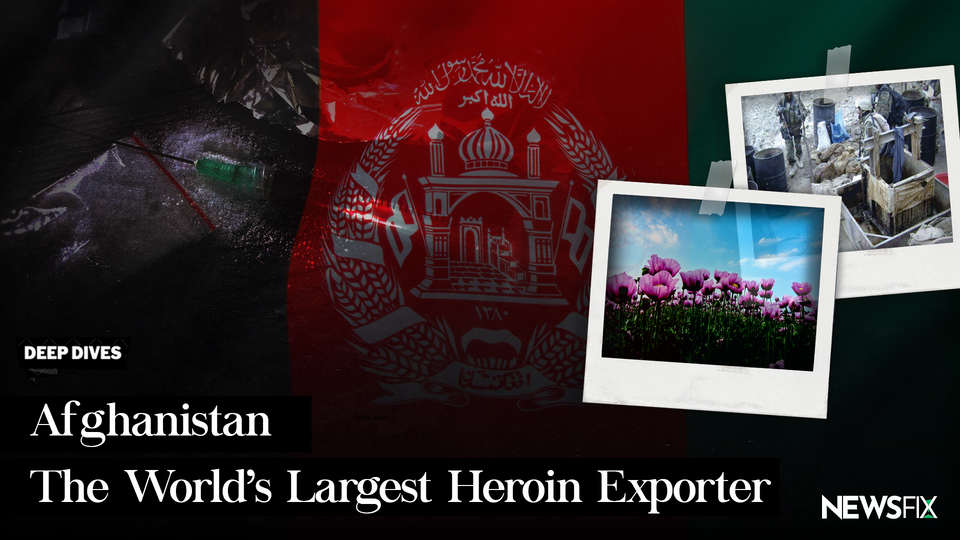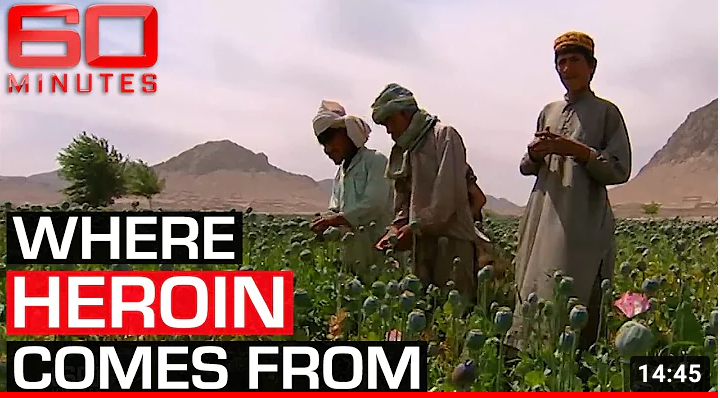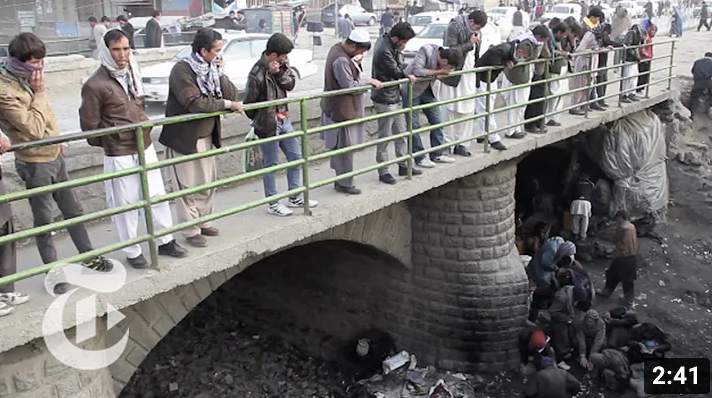🇦🇫 Afghanistan: The World's Largest Heroin Exporter

Morning all,
This Tuesday will mark six months since the fall of Kabul, the chaotic withdrawal of US troops, and the return to Taliban rule in Afghanistan.
In the months since, with the majority of the western world not recognising the Taliban as the country's legitimate government, there's a complex dilemma for millions desperately in need of foreign aid.
That reduction in financial aid has led to more than half of the country going hungry, and also shone a light on Afghanistan’s illegal industry. It has been described as "the region’s most reliable economic engine”- the production of heroin.
Until Monday,
Your Fixers
OKAY, BEFORE WE BEGIN…
To really benefit from reading this piece, a very basic understanding of both Afghanistan and Opium is required. We’ve kept it as simple as possible for you, and hope it is helpful!
AFGHANISTAN
Officially known as the “Islamic Republic of Afghanistan”, it is a land-locked country in Central Asia, bordering Turkmenistan, Uzbekistan, Tajikistan, Pakistan and Iran.
The country has a population of almost 40 million people, with roughly one in ten living in the capital city of Kabul. The official languages spoken are Dari and Pashtu.
Throughout history, its strategic location between the Middle East and Eastern Asia has made it a prize sought by empires for millennia. However, many have tried - and failed - to overtake the country. Back in August, many were reminded of the old saying - 'The Graveyard of Empires'.
OPIUM - WHAT IS IT?
You’ve seen a poppy plant before, right? Well, opium is created from the unripe seedpods of a poppy plant.
Inside these seedpods is opium - a white and sticky liquid. After being extracted from the seedpod, opium can be refined into highly-addictive and powerful drugs, including heroin.
Afghanistan’s climate happens to be well-suited for the production of poppy plants, and thus the production of heroin.
So much so, that the latest UN statistics suggest that in 2020 opium produced in Afghanistan accounted for 85% of global production, and supplied some 80% of all opiate users in the world.
In recent years, Afghanistan’s opium production has exploded - and in 2020 three times as much land was being used to grow opium poppies than during the 1980s.
Since monitoring began in 1994, land being used to grow opium poppies has increased on average by 4,000 hectares every year. That is equivalent to 5,600 football pitches.
The majority (89%) of opium poppy farming takes place in the south-west of the country - a location close to the borders of other countries used in the drug smuggling route.
In Helmand province, for example, roughly 20% of land is dedicated to opium production.
ECONOMIC VALUE
In total, the UN estimated that in 2021, the opium industry accounted for 9-14% of Afghanistan’s total GDP. This exceeds the value of legal goods and services - estimated at 9% of GDP in 2020.
For context, at the height of Colombia’s drug trade in the 1980s, the industry was worth 6% of Colombia’s GDP.
In terms of the actual money - income from opioids in Afghanistan amounted to between $1.8-$2.7 billion in 2021.
The incentive to grow opium poppies is clear - a farmer in the country could sell wheat for $0.2 per kilogram, but opium for $350 per kilogram.

However, the real value of opium is to be found after it is processed into heroin and sold in foreign markets.
Smuggling the drug to certain regions has higher rewards than others - with Australia being the most profitable. There, one kilogram is worth more than $160,000 USD.
However, transporting the drug from Afghanistan to other countries and regions is no simple task - and it requires a distribution network.
THE DISTRIBUTION
Opium from Afghanistan is exported to every world region except for Latin America. In order to achieve this, a vast network of trafficking routes have been developed - with the drugs smuggled over land, sea and air.
As the UN map below shows, there are three general routes out of Afghanistan through which heroin and other opioids are exported. The Balkan and northern routes serve Russia and Europe - and previously were the primary direction of exports.
However, in recent years the southern route has become dominant - and through it are the markets of Asia and Africa, as well as Western and Central Europe.
The heroin industry in Afghanistan is firmly established, profitable and central to the global market.
Producing the drug has become critical to the country’s economy - and many rural farmers are reliant on growing opium, but how and when did it really begin?
HOW DID IT ALL REALLY BEGIN?
Let’s take it back a bit - back to 1979, a time where the Cold War continued, Jimmy Carter was US president, and the Soviet Union was expected to last forever.
Opium poppies have been grown and cultivated in Afghanistan for centuries, but they became particularly popular after the Soviet Union invaded the country in 1979.
The conflict destabilised rural Afghanistan, and opium provided a reliable source of income for local populations there. In addition, the Mujahideen - the US-backed guerrilla groups fighting the Soviets - also used the opium industry to finance their resistance.
After the Soviets left Afghanistan in 1989, civil war descended upon the country - and the opium trade was used by warlords and by local militias to finance conflict. The war largely became about who controlled drug supply lines.
THE TALIBAN
One faction that emerged during the civil war became known as the Taliban - a group that garnered popular support with a promise of security and religious fervour. In Pashto, Taliban is the plural of 'Talib' - meaning student. Most Taliban members are Pashtun.
By 1996, the Taliban took over the capital city of Kabul - and held control over the majority of the country.
In government, the Taliban combined strict religious ideology with a conservative social code - resulting in a brutal and repressive regime. Early on in their rule, they banned opium - describing intoxicants as “a great crime to Islam”.
However, the ban triggered backlash and the Taliban rescinded it - instead choosing to tax opium from 1996. The industry grew and exports made up 75% of the global supply chain at the time.
It’s important to remember that during their first time in power - between 1996 and 2001 - the Taliban were described as having "one of the worst human rights records in the world". Under their brutal interpretation of Sharia Law - women could be stoned to death for adultery.
To get around the religious contradiction of the drug trade, the Taliban stated it was acceptable to grow and sell opium to foreign ‘infidels’, but not for the local population to consume it themselves.
By 2000, there was another change in stance - with the Taliban once again banning poppy planting in a bid for international legitimacy and aid.
Initially, the ban was highly effective, and the UN estimated it led to a 90% decrease in production between 2000 and 2001 - cutting the global supply chain of heroin by two thirds. At the time, it was described as “the most effective opium ban in history”, but farmers began to defy it within a year.
THE US INVASION
Like a lot of the world’s recent history, a country’s policies, cultures and laws can often be separated into pre and post-9/11. This is no different.
In a direct response to the 9/11 attacks, the US invaded Afghanistan in 2001, toppling the Taliban’s rule within weeks.
Almost immediately, Afghanistan’s opium production restarted. The Taliban "dove into the industry" and used the illicit profits to "fund their insurgency against the most powerful military in the world".
Estimates suggest the drug trade in 2017 made up at least 60% of the Taliban’s income.
Combatting the production of opium - which was finding its way onto US soil - was a major priority for US forces. Between 2002 and 2017, they spent $8.6 billion in their attempts to crack down on the industry.
The US paid farmers to grow crops instead of poppies. However, this was far less profitable - and farmers who made $3,000 annually from poppies would make considerably less if they switched to wheat.
“[Heroin] fuels corruption, it discourages private investment, it undermines governance, it creates violence and instability, when the drug traffickers and the Taliban are collaborating they collaborate effectively. But when they are just working independently they’re both going after the same aims - which is to weaken the government, to weaken society, to weaken democracy, to weaken rule of law, to foment violence, to foment instability.” - William Wood, US Ambassador to Afghanistan, 2007-2009
A LOSING BATTLE?
In further efforts to tackle heroin production, the US sprayed herbicide on poppy fields - damaging the livelihoods of farmers and eroding their support amongst locals.
Eradication did have some success in parts of the country, but the prices of opium on the black market subsequently increased - further encouraging cultivation.
While for years most of the harvest was smuggled out of the country in the form of bulky opium syrup, officials in 2017 said “at least half of Afghan opium is processed in the country”.
In total, an estimated 590,000 jobs depended on growing poppies and the Taliban extracted levies for protecting the farms. One study estimated that in 2018, the Taliban made $39.9 million through this.
Overall, US efforts to stamp out heroin production in Afghanistan failed significantly, with the 20 years during US boots on the ground often described as the “golden age” for the country’s heroin industry.
“The total area under poppy cultivation in Afghanistan was estimated at 224,000 hectares - almost 900 square miles - in 2020, a 37% increase from 2019. - Context from The New York Times
In February 2021, the US began what ultimately became a hurried and chaotic withdrawal from Afghanistan. Some analysts argue America's perceived failures in Afghanistan cannot be understood separately from the impact of the heroin trade.
“America was defeated as much by the industry drug laws it helped to create, as by any rebel group of militant ideology.” - VICE analysis
THE CURRENT SITUATION
When the Taliban marched back into power in August, they initially said they would once again stamp out the production of opium. However, by November they said there was no longer a goal of eradicating poppy cultivation.
One of the factors to take into consideration here is the economic angle in all of this. As mentioned before, by all estimates the industry represents at least 9% of GDP, and provides hundreds of thousands of jobs.
When the Taliban took over, the US froze both $9 billion worth of Afghanistan’s assets and the country’s central banks. Foreign aid from many countries has been dramatically slashed, aid which in 2019 paid for 75% of Afghanistan’s public spending.
Russia and China are two of the few countries maintaining embassies in Kabul - but any support from those countries is unlikely to make up for the loss of support from the west.
This loss of international assistance could, according to the UN, be offset by an increase in illegal activities.
“In view of the volatile security situation, protracted economic crisis and health emergency, the international community must urgently provide basic needs and services to the people of Afghanistan to promote sustainable reductions in illicit drug cultivation, production and demand” - UN Analysis
All the while, estimates suggest 2.6% of Afghanistan’s population are themselves addicted to opioids - one of the highest rates of addiction in the world.

We hope you found this piece helpful and interesting - thank you for reading, and for your support of NewsFix!
